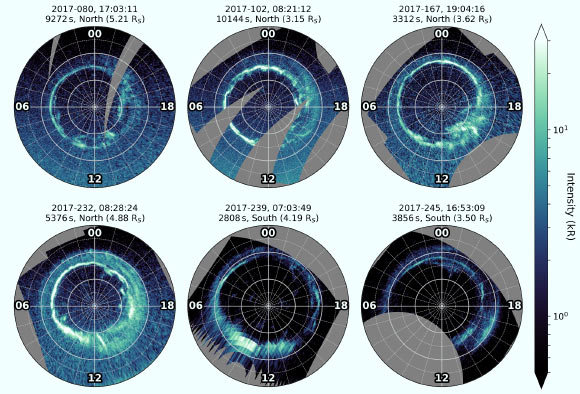At the end of its mission in 2017, NASA’s Cassini spacecraft performed a set of ‘Grand Finale’ orbits bringing it closer to Saturn than ever before. By passing over the gas giant’s polar regions at such low altitude, the orbiter’s ultraviolet camera could observe Saturn’s auroras in unprecedented resolution and its onboard instruments could measure charged particles and plasma waves directly above the auroral region. These observations reveal for the first time the detailed structure of the main auroral arc which varies between a smooth and a rippled shape, likely depending on how quiet or disturbed the plasma near Saturn is. The observations also suggest the existence of strong electric fields which act to accelerate electrons down into the Saturnian atmosphere, driving the bright auroral emissions.

Composite of a true color image of Saturn, observed by Cassini in 2016, overlaid with a false color representation of the ultraviolet aurora in the northern hemisphere as observed on August 20, 2017. Image credit: NASA / JPL-Caltech / Space Science Institute / A. Bader, Lancaster University.
Saturn’s auroras are generated by the interaction of the solar wind with the rapidly rotating magnetic field of the giant planet.
They are located in Saturn’s polar regions and known to be highly dynamic, often pulsating and flashing as different dynamic processes occur in the planet’s plasma environment.
“Surprisingly many questions revolving around Saturn’s auroras remain unanswered, even after the outstanding success of the Cassini mission,” said Alexander Bader, a Ph.D. student at Lancaster University.
“This last set of close-up images gives us unique highly detailed views of the small-scale structures which couldn’t be discerned in previous observations by Cassini or the NASA/ESA Hubble Space Telescope.”
“We have some ideas about what their origin could be, but there is still a lot of analysis to be done.”

Selection of full views of the northern and southern auroral oval obtained during Cassini’s Grand Finale mission phase. The images are sorted by the time of their observation; start time, exposure time, observed hemisphere and radial distance of Cassini from Saturn’s surface are given at the top of each panel. The differences in background brightness (dayglow) between the northern and southern hemisphere are a seasonal effect; 2017 was a year of northern summer and southern winter. Image credit: Bader et al, doi: 10.1029/2019GL085800.
Satellite imagery alone will hardly be enough to unravel the aurora’s mysteries — the energetic particles causing the bright lightshows around Saturn’s poles originate far away from the planet’s surface where magnetic field lines twist and clouds of plasma interact with one another.
When located in the right region, Cassini was sometimes embedded in the particle stream connecting the auroras to the magnetosphere.
An analysis of the spacecraft’s particle measurements recorded during these times showed that Saturn’s auroras, like Jupiter’s, are generated by much more energetic particles than Earth’s.
However, the underlying physical mechanisms appear to show similarities between all the three.
“Even though Cassini’s mission is over, the data it provided remain full of surprises and will continue to help us understand the workings of giant planet auroras, especially in combination with Juno observations of Jupiter’s magnetosphere,” the researchers said.
The new observations are detailed in two papers published in the journal Geophysical Research Letters and the Journal of Geophysical Research: Space Physics.
_____
A. Bader et al. The morphology of Saturn’s aurorae observed during the Cassini Grand Finale. Geophysical Research Letters, published online December 24, 2019; doi: 10.1029/2019GL085800
A. Bader et al. Energetic Particle Signatures Above Saturn’s Aurorae. JGR: Space Physics, published online December 22, 2019; doi: 10.1029/2019JA027403







